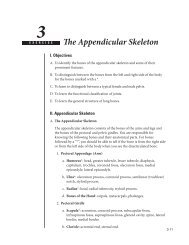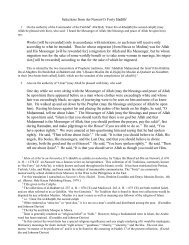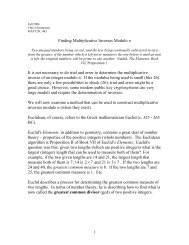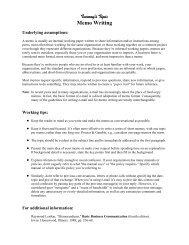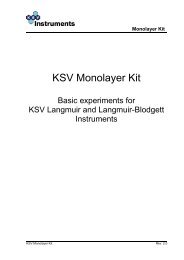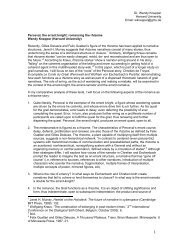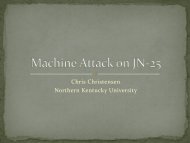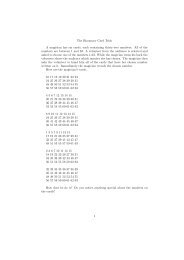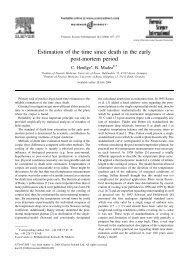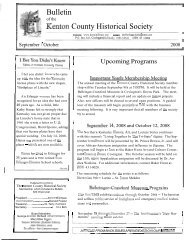SMS4 - Northern Kentucky University
SMS4 - Northern Kentucky University
SMS4 - Northern Kentucky University
You also want an ePaper? Increase the reach of your titles
YUMPU automatically turns print PDFs into web optimized ePapers that Google loves.
6 JEREMY ERICKSON, TAYLOR UNIVERSITY<br />
4. Gröbner Basis and SAT Solver Attacks over GF(2)<br />
The primary attempt to attack <strong>SMS4</strong> in this paper is based on solving a system of<br />
equations over GF(2). The equations are divided into two groups, one representing<br />
the key schedule for the entire cipher, and one with a representation of the round<br />
function process for each plaintext/ciphertext pair. The Magma code is written<br />
in such a way that full and simplified <strong>SMS4</strong> can easily be compared by changing<br />
which predefined functions are loaded. (Some code in the Magma implementation<br />
was written by Brian Nixon.)<br />
4.1. Modelling the Inversion Step. The calculation of inversion in the S-box<br />
calculation can be done with several models. The simplest model is XY − 1 = 0<br />
for X, Y ∈ GF(2 8 ), which is only of degree 2. However, this model will not yield<br />
a solution for X = 0, and thus is not always sufficient to model the cipher. An<br />
alternative model is Y 2 X − Y = 0, which is still degree 2 when represented over<br />
GF(2) due to the property that x 2 = x, x ∈ GF(2). However, in this case, an<br />
extraneous solution Y = 0 is present for any input X, even when X is nonzero.<br />
Thus, the equation X 2 Y − X = 0 must be added to the system to yield a correct<br />
solution. For this reason, most previous attacks (c.f.e. [8]) use XY − 1 = 0 as the<br />
model for the cipher.<br />
To model the inversion over GF(2), we simply represent the coefficients on the<br />
polynomials for X and Y as variables in GF(2), perform the necessary operations,<br />
and mod by the appropriate irreducible polynomial. This was done using Magma<br />
for this project.<br />
The question with the simplified XY −1 = 0 model is how frequently it provides<br />
a correct result. One of 256 inputs (for <strong>SMS4</strong>) or 16 inputs (for S-<strong>SMS4</strong>) will<br />
require the inversion of zero. The round function for each round calls S(x) once,<br />
and thus s(x) four times for <strong>SMS4</strong> and two times for S-<strong>SMS4</strong>. The same numbers<br />
occur for the key schedule, so a round of <strong>SMS4</strong> will use inversion eight times and a<br />
round of S-<strong>SMS4</strong> will use inversion four times. The simplest probability model is<br />
to assume that all inputs to the S-boxes are independent and random. Denote the<br />
number of rounds as r. Thus, for <strong>SMS4</strong>:<br />
(9) Pzinv = 1 −<br />
and for S-<strong>SMS4</strong>:<br />
(10) Pzinv = 1 −<br />
� �8r 255<br />
256<br />
� �4r 15<br />
16<br />
In particular, for the full 32 rounds of <strong>SMS4</strong>, Pzinv = 1 − � �<br />
255 256 1<br />
256 ≈ 1 − e or<br />
63.28%, and for the full 8 rounds of S-<strong>SMS4</strong>, Pzinv = 1 − � �<br />
15 32<br />
16 ≈ 87.32% To test<br />
this model, we can also examine the expected number of zeros, which is simply 8r<br />
256<br />
for full <strong>SMS4</strong> and 4r<br />
16<br />
for S-<strong>SMS4</strong>.<br />
To verify these numbers, I used Magma to perform 10,000 random encryptions<br />
(random key and plaintext) for each multiple of 4 rounds, recording the number of<br />
zeros encountered at inversion and the number of encryption processes which used<br />
one or more zeros. The results are in table 3.<br />
We can see that the model closely matches the data. Thus, <strong>SMS4</strong> does behave<br />
like a random system, and we are justified in making our zero inversion predictions



